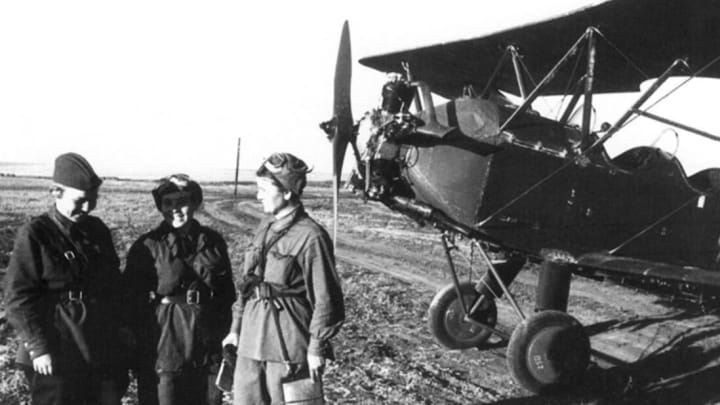During World War II, American women were put to work; in Russia, women were put to war. In 1941, Operation Barbarossa meant the invasion of the Soviet Union by Nazi forces, and the Soviets’ foray into an untapped reservoir of strength: female bomber pilots. Though Soviet women were barred from combat at the beginning of the war, a record-breaking aviatrix named Marina Raskova (hailed as the “Soviet Amelia Earhart”) was later called upon by Joseph Stalin to organize a regiment of young female pilots to fight the German invaders, making the Soviet Union the first nation to allow women to fly combat missions.
Primitive Planes
Wikimedia Commons
At its largest, the 588th Night Bomber Regiment was made up of 40 two-person crews, all between the ages of 17 and 26. The women flew repurposed 1920s biplanes, made of canvas-draped plywood, that were previously used mostly for crop dusting. The primitive planes lacked many basic instruments, including radios—navigation was done with a stopwatch and a map. If hit, the flimsy aircrafts would burn up immediately. The pilots did not carry parachutes. The aircrafts were so small that they could only carry two bombs at a time, so the pilots were required to carry out multiple missions per night—sometimes as many as 18.
Earning the Nickname through Fright Flight
Though the planes were slow and obsolete, the resourceful Russians capitalized on the planes’ maneuverability, which allowed them to deftly dodge German bullets. As a stealth technique, the bombers would idle their engines as they approached the target, then glide the rest of the way—leaving only the “whoosh” of their aircrafts in the wind to give them away. The sound reminded German soldiers of a witch’s broomstick, thus dubbing the bombers “Nachthexen,” or “night witches.” The Germans attributed the witches’ incredible stealth to special injections and pills taken to give them “feline-like” night vision. So feared were the mysterious bombers that, supposedly, any German who shot one down was automatically awarded an Iron Cross.
Courtesy of The Image Works; Standing: Nadezhda Vasilyevna Popva
Nadezhda Vasilyevna Popova, one of the first young women to enlist, recalled her inaugural mission, in which two of her friends were fatally shot down. “I was ordered to fly another mission,” she said in a 2003 interview with Russian Life magazine. “It was the best thing to keep me from thinking about it.” She later commented, “Almost every time, we had to sail through a wall of enemy fire.” Once, after narrowly completing a raid, Popova counted 42 bullet holes in her fragile plane.
Not Just 'A Bunch of Girlies'
The “witches” faced harsh opposition on the home front, as well. Despite their harrowing missions and unquestionable bravery, the witches’ abilities were often doubted by their male counterparts. A male general once complained about being sent “a bunch of girlies” instead of soldiers; needless to say, the doubters were soon silenced. Even while allegedly drawing flowers on their planes and coloring their lips with navigation pencil, the women of the 588th Night Bomber Regiment flew roughly 30,000 missions, dropping a total of 23,000 tons of bombs on the invading Nazi armies.
Popova, who passed away earlier this month at the age of 91, marveled at the young pilots’ moxie long after the war’s end. “I sometimes stare into the blackness and close my eyes,” she said in 2010. “I can still imagine myself as a young girl, up there in my little bomber. And I ask myself, ‘Nadia, how did you do it?’”
Sources: The Atlantic, The Vancouver Sun, The New York Times, Seize the Sky, Wikipedia
The primary image is courtesy of Quality Time.
